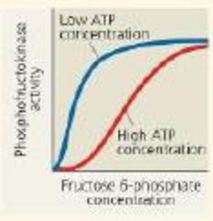
Concept explainers
INTERPRET THE DATA Phosphofructokinase is an enzyme that acts on fructose 6-phosphate at an early step in glucose breakdown. Regulation of this enzyme controls whether the sugar will continue on in the glycolytic pathway. Considering this graph, under which condition is phosphofructokinase more active? Given what you know about glycolysis and regulation of

Want to see the full answer?
Check out a sample textbook solution
Chapter 9 Solutions
Campbell Biology (10th Edition)
Additional Science Textbook Solutions
Biology: Life on Earth with Physiology (11th Edition)
Campbell Essential Biology (7th Edition)
Microbiology Fundamentals: A Clinical Approach
Human Physiology: An Integrated Approach (8th Edition)
- Introduction to blood lab reportarrow_forwardWhich of the structural components listed in the Essential terms of section 1.3 (Cell components) could occur in a plant cell? Paragraph く BIUA 川く く 80 + кл Karrow_forwardWhich of the following statements refer(s) directly to the cell theory? (Note that one or more correct answers are possible.) Select 2 correct answer(s) a) There are major differences between plant and animal cells. b) There are major differences between prokaryote and eukaryote cells. c) All cells have a cell wall. d) All cells have a cell membrane. e) Animals are composed of cells. f) When a bacterial cell divides, it produces two daughter cells.arrow_forward
- Preoperative Diagnosis: Torn medial meniscus, left knee Postoperative Diagnosis: Combination horizontal cleavage tear/flap tear, posterior horn, medial meniscus, left knee. Operation: Arthroscopic subtotal medial meniscectomy, left knee Anesthetic: General endotracheal Description of Procedure: The patient was placed on the operating table in the supine position and general endotracheal anesthesia was administered. After an adequate level of anesthesia was achieved, the patient's left lower extremity was prepped with Betadine scrubbing solution, then draped in a sterile manner. Several sites were then infiltrated with 1% Xylocaine solution with Epinephrine to help control bleeding from stab wounds to be made at these sites. These stab wounds were made anterolaterally at the level of the superior pole of the patella for insertion of an irrigation catheter into the suprapatellar pouch area, anterolaterally at the level of the joint line for insertion of the scope and anteromedially at…arrow_forwardUARDIAN SIGNA Life Sciences/ Baseline Test Grade 10 ry must be written in point form. pot in full sentences using NO MORE than 70 words sentences from 1 to 7. only ONE point per sentence. words as far as possible. number of words you have used in brackets at the end GDE/2024 QUESTION 3 The table below shows the results of an investigation in which the effect of temperature and light on the yield of tomatoes in two greenhouses on a farm was investigated. TEMPERATURE (°C) AVERAGE YIELD OF TOMATOES PER 3.1 PLANT (kg) LOW LIGHT LEVELS HIGH LIGHT LEVELS 5 0,5 0,5 10 1,5 2,5 15 3,0 5,0 20 3,6 8,5 25 3,5 7,8 30 2,5 6,2 State TWO steps the investigator may have taken into consideration during the planning stage of the investigation. (2) 3.2 Identify the: a) Independent variables (2) b) Dependent variable (1) 3.3 Plot a line graph showing the results of the average yield of the tomatoes from 5°C to 30°C for low light levels. (6) 3.4 State ONE way in which the scientists could have improved the…arrow_forwardExplain why you chose this mutation. Begin by transcribing and translating BOTH the normal and abnormal DNA sequences. The genetic code below is for your reference. SECOND BASE OF CODON כ FIRST BASE OF CODON O THIRD BASE OF CODON SCAGUCAGUGAGUCAG UUU UUC UCU UAU UGU Phenylalanine (F) Tyrosine (Y) Cysteine (C) UCC UAC UGC Serine (S) UUA UUG Leucine (L) UCA UCG_ UAA UGA Stop codon -Stop codon UAG UGG -Tryptophan (W) CUU CUC CCU CAU CGU Histidine (H) CCC CAC CGC -Leucine (L) Proline (P) CUA CCA CAA CUG CCG CAG-Glutamine (Q) -Arginine (R) CGA CGG AUU ACU AAU AGU AUC Isoleucine (1) Asparagine (N) ACC AAC Threonine (T) AUA ACA AAA Methionine (M) Lysine (K) AUG ACG Start codon AAG AGC-Serine (S) -Arginine (R) AGA AGG GUU GCU GAU GUC GUA GUG GCC Valine (V) -Alanine (A) GCA GCG GAC GAA GAG Aspartic acid (D) GGU Glutamic acid (E) GGC GGA GGG Glycine (G) In order to provide a complete answer to the question stated above, fill in the mRNA bases and amino acid sequences by using the Genetic Code…arrow_forward
- identify the indicated cell in white arrowarrow_forwardGloeocaspa Genus - diagram a colony and label the sheath, cell wall, and cytoplasm. Oscillatoria Genus - Diagram a trichome, and label the shealth and individual cells Nostoc Genus- diagram a sketch of the colonoy microscopically from low power to the left of the drawing. Draw a filament showing intercalary heterocysts, and vegatative cells to the right of the drawing Merismopedia Genus- diagram a sketch of the colony. draw and label a filament showing the colony, cell wall, and sheath. Gloeotrichia Genus- diagram a habit sketch of the colony. draw a filament showing the heterocyst, akimetes and vegatative cells of the filamentarrow_forwardOf this list shown, which genus does the image belong toarrow_forward
 Human Physiology: From Cells to Systems (MindTap ...BiologyISBN:9781285866932Author:Lauralee SherwoodPublisher:Cengage Learning
Human Physiology: From Cells to Systems (MindTap ...BiologyISBN:9781285866932Author:Lauralee SherwoodPublisher:Cengage Learning
 BiochemistryBiochemistryISBN:9781305577206Author:Reginald H. Garrett, Charles M. GrishamPublisher:Cengage Learning
BiochemistryBiochemistryISBN:9781305577206Author:Reginald H. Garrett, Charles M. GrishamPublisher:Cengage Learning Biology (MindTap Course List)BiologyISBN:9781337392938Author:Eldra Solomon, Charles Martin, Diana W. Martin, Linda R. BergPublisher:Cengage Learning
Biology (MindTap Course List)BiologyISBN:9781337392938Author:Eldra Solomon, Charles Martin, Diana W. Martin, Linda R. BergPublisher:Cengage Learning Concepts of BiologyBiologyISBN:9781938168116Author:Samantha Fowler, Rebecca Roush, James WisePublisher:OpenStax College
Concepts of BiologyBiologyISBN:9781938168116Author:Samantha Fowler, Rebecca Roush, James WisePublisher:OpenStax College





